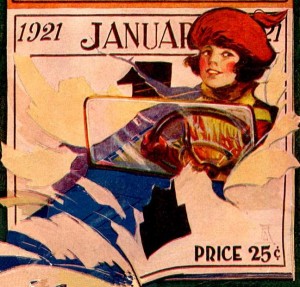John Sloan (1871-1951)
Picture a 19th century man and woman riding side by side in a one-horse carriage. Now, put the whip and reigns into the woman’s hands. What is this image about?
This illustration by John Sloan was created to accompany a story about a rake, Ned Wainright, his twin brother Buck, and their younger sister Janie. As Ned describes his family, their “. . . father was . . . helpless, Buck . . . indolent, Janie was willful.” Unfortunately the clipping with this story and illustration from The Philadelphia Inquirer is incomplete with only a portion of the printed text saved.
What is intriguing about Sloan’s illustration is that it appears that the willful Janie is driving the carriage with an older gentleman (one of her brothers?) seated beside her. She smiles broadly, he watches her with his head tipped to one side as though in speculation about who she is. From our 21st century perspective we might wonder if this illustration was about shifting gender roles in1895? If so, is it a reflection of the burgeoning feminism movement in late 19th centuryAmerica?** Let’s consider the visual evidence.
Thirty years before, a similar illustration reflected a shift in women’s roles in the wake of the Civil War. A quick comparison between the two images discloses that in Sloan’s picture the girl’s companion looks back at her with an apprising look. Winslow Homer’s 1865 illustration shows that both man and woman look shadowed and glum—life is undoubtedly tougher for both of them.
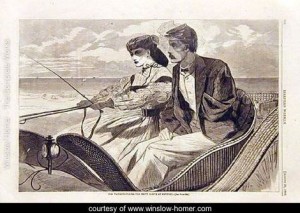 Winslow Homer (1836-1910)
Winslow Homer (1836-1910)
Our Watering Places–The Empty Sleeve at Newport, 1865
Illustration for Harper’s Weekly IX, # 452 (August 26, 1865): 532.
Wood engraving
The Homer illustration accompanied a story in Harper’s Weekly, titled, “The Empty Sleeve at Newport; or, Why Edna Ackland Learned to Drive.” Captain Harry Ash, having lost an arm during the Civil War, returned home seeking the girl he loved, Edna Ackland, who, he discovered, had learned to drive a horse and buggy during his protracted absence. Returning soldiers found themselves confronting women who, having adjusted to changed circumstances that occurred during the war, often took up their men’s responsibilities. After the war was over these same women sometimes took on a stronger role in their relationships. Captain Ash and Edna Ackland resolve their relationship dilemma–as she explains to him, “I must be left and right hand [for you] . . . . And I learned, as I have learned many things, for love of you.” The dominant role of the 19th-century male nevertheless prevails when the author declares at the story’s end: “Yet, for all that, his eye is on the road and his voice guides her; so that, in reality, she is only his left hand, and he, the husband, drives.”
Before the end of the 19th century, women were typically relegated to the position of passengers in their conveyances–driving was done by servants, hired drivers, or one’s male escort. Horses were big and needed considerable physical strength to control. If a woman desired to drive her own horse-drawn carriage she was often accompanied by her servant sitting behind his mistress ready to assist her in a moment’s notice. As you can see in Mary Cassatt’s 1879 painting of a woman driving her carriage showing her servant seated at the back.
Mary Cassatt (1844-1926)
Woman and Child Driving, 1881
Oil on canvas
Philadelphia Museum of Art
In the early fall of 1897, Harper’s New Monthly Magazine published a promotional poster by Edward Penfield picturing a statuesque woman accompanied by man who appears to be her coachman. She holds the carriages reigns and a horse-whip in her hands. Her less-imposing companion sits passively beside her, his arms folded against his chest. In the new century Penfield would also illustrate women driving automobiles, but at the end of the old century one of his last posters for Harper’s shows an unaccompanied woman driving her horse-drawn cart picking up her husband at the train station.
Edward Penfield (1866-1925) Edward Penfield (1866-1925)
Poster for Harper’s New Monthly Poster for Harper’s New Monthly Magazine
Magazine (September 1897) (August 1899)
Not until the end of the 19th century was it acceptable for women to drive their own carriages, which were typically designed to be lighter in weight and of a lower profile so that if unaccompanied a woman might alight without assistance and still have the strength to control the animal and vehicle.
Even with the advent of the automobile, there were similar discussions of a woman’s suitability with regards to handling a powerful auto. Montgomery Rollins in a 1909 article magazine wrote, “It’s no child’s play to run a motor car. No license should be granted to one under eighteen, and . . . never to a woman, unless, possibly, for a car driven by electric power.”*** Not suited to distance driving or high speeds, the electric car was considered safer for a woman because it was quieter, cleaner, and easier to operate. Not surprising, women did not necessarily seek only simplicity and ease—like men, some desire and desired power, speed, and control.
After the passage of the women’s voting rights amendment in 1920, American woman were on the cusp of a new age and even illustration showed their verve as they embraced the new era. The cover illustration for the January 1921 issue of American Automobile Digest (seen below) shows an exuberant young woman driving her auto through the January 1st calendar page in celebration of her new freedom.
F. D. L. (unknown)
Cover illustration for American Automobile Digest (January 1921)
Hope a smashing New Year is just around the corner for us all!
* The New-York Evening Post later known as the New York Post, is the nation’s oldest continuously published daily newspaper.
* In 1890 the National Women Suffrage Association and the American Women Suffrage Association merged to form the National American Woman Suffrage Association. This new organization organized state by state campaigns to obtain voting rights for women. Although the Wyoming Territory already allowed women’s suffrage when it was admitted to the Union in 1890, in 1893, Colorado was the first state to pass a referendum granting its women residents the right to vote.
*** “Sane Motoring—Or Insane?” by MontgomeryRollins, The Outlook (May 29, 1909): 279.
December 27, 2012
By Joyce K. Schiller, Curator, Rockwell Center for American Visual Studies, Norman Rockwell Museum


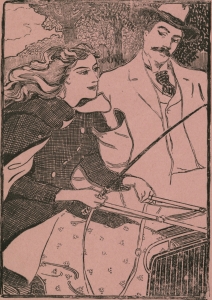
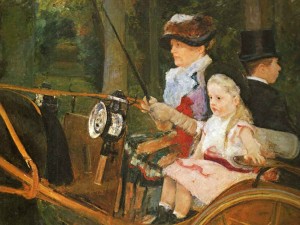
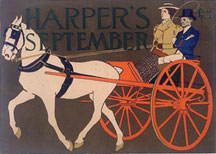
![81_woman_driving_a_coach[1]](https://www.rockwell-center.org/wp-content/uploads/2012/12/81_woman_driving_a_coach1-300x279.jpg)
